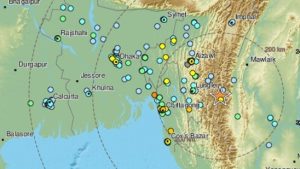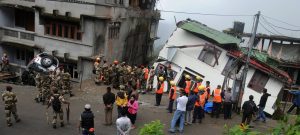Powerful Earthquake Hits Border Region, Triggers Panic
A powerful earthquake measuring 6.0 on the Richter scale struck the India-Myanmar border region, sending tremors across northeastern India and parts of Myanmar. The quake, which occurred in the early hours, caused panic among residents as buildings shook, and people rushed outdoors for safety.
According to the National Center for Seismology (NCS), the earthquake’s epicenter was located in Myanmar, near the Indian border, at a depth of approximately 50 kilometers. The tremors were felt in multiple Indian states, including Assam, Nagaland, Manipur, Mizoram, Tripura, and West Bengal. Residents in Kolkata and Guwahati, some of the most densely populated cities in the region, experienced noticeable shaking that lasted for a few seconds.
Residents Describe the Frightening Experience
People across the affected regions reported strong shaking and vibrations in their homes. “I was asleep when I suddenly felt my bed shaking. My heart started pounding, and I immediately woke my family up,” said a Guwahati resident. Others described hearing windows rattling and furniture moving slightly.
In Kolkata, several high-rise apartments reported swaying sensations, causing alarm among residents. “We live on the 12th floor, and the entire building felt like it was rocking back and forth. It was terrifying,” shared a Kolkata resident. Many people rushed out of their homes, seeking open spaces to avoid the risk of structural damage.
On social media, users quickly began sharing their experiences, with hashtags related to the earthquake trending. Several posts included video clips showing chandeliers swinging, water bottles toppling, and pets reacting nervously to the tremors.

Seismologists Explain the Impact
Seismologists from the Indian Meteorological Department and the National Center for Seismology have attributed the strong tremors to the earthquake’s moderate depth and its location in a seismically active zone. “The northeastern region of India, along with Myanmar, sits on the complex tectonic boundary between the Indian Plate and the Eurasian Plate, making it prone to frequent earthquakes,” explained a senior seismologist.
“The depth of 50 kilometers means that the quake was not shallow, which helped reduce surface-level destruction. However, due to its magnitude, it was widely felt across a large area,” he added.
Experts also warned that aftershocks might follow, though their intensity and timing remain uncertain. “People should remain cautious for at least 24 hours after such a quake. If aftershocks occur, they may be weaker, but they can still cause structural damage,” said a disaster management expert.
Government and Authorities Assess the Situation
Following the earthquake, government agencies and disaster response teams began assessing the affected areas for potential damage or casualties. Officials reported that while the shaking was strong, no immediate loss of life or significant property damage had been confirmed.
“So far, we have not received any reports of major destruction, but we are in touch with local authorities across affected states,” stated an official from India’s Disaster Management Department. He added that relief teams were on standby in case of emergency evacuations or assistance requests.
In Myanmar, authorities also launched an assessment of the affected regions, particularly those near the epicenter. Initial reports suggested that some structures sustained minor cracks, but no major casualties had been recorded.
Infrastructure and Safety Concerns
While the immediate damage appeared limited, experts warned about the long-term effects of repeated seismic activity on infrastructure. “Many buildings in northeastern India and parts of Myanmar are not designed to withstand strong earthquakes. This makes them vulnerable to even moderate tremors,” said an urban planning expert.
Several organizations have been advocating for stricter building codes and retrofitting measures in seismic zones. “We need to learn from past earthquakes and invest in earthquake-resistant construction. The risk will only increase if safety measures are ignored,” he added.
In some areas, minor structural damage was reported, particularly in older buildings. Cracks were observed in walls, and a few roads developed small fissures. Authorities urged people to avoid using damaged structures until proper inspections were conducted.
Northeast India: A High-Risk Seismic Zone
The northeastern region of India is known for its high seismic activity, as it lies in one of the most earthquake-prone zones in the world. Over the years, the region has witnessed several major quakes, some of which caused severe destruction.
One of the most devastating earthquakes in the region occurred in 1950 when an 8.6 magnitude quake struck Assam, leading to widespread destruction and loss of life. Since then, numerous moderate to strong earthquakes have been recorded, reinforcing the need for preparedness.
A geologist from the Geological Survey of India explained, “This region is prone to frequent seismic activity due to ongoing tectonic movements. While we cannot predict earthquakes, we can certainly prepare for them through early warning systems and better infrastructure planning.”
Residents Urged to Stay Alert
Authorities have advised residents in the affected areas to stay vigilant and follow earthquake safety guidelines. “It is crucial to have an emergency plan in place. People should identify safe spots in their homes, such as under sturdy furniture, and avoid standing near windows or heavy objects during an earthquake,” suggested a disaster management official.
Experts also recommended keeping emergency kits ready, including essentials such as water, food, flashlights, and first-aid supplies. “In earthquake-prone regions, preparedness can make a huge difference in saving lives,” said an official from the National Disaster Response Force (NDRF).
Several schools and offices in the affected cities issued advisories, instructing staff and students on emergency evacuation procedures. Some organizations conducted earthquake drills to ensure preparedness in case of future tremors.
Impact on Transportation and Communication
The earthquake temporarily disrupted transportation and communication services in some areas. Metro rail services in Kolkata briefly halted operations as a precautionary measure. “We conducted a safety inspection of tracks and stations before resuming operations,” said an official from Kolkata Metro.
In Guwahati, some mobile networks experienced congestion as people rushed to call their family members. “For a few minutes, my calls wouldn’t connect. Everyone was trying to check on their loved ones,” said a local resident. However, network providers restored services quickly, and no major outages were reported.
Airports in the affected regions continued normal operations, with aviation authorities confirming that no flight delays or damages were reported due to the tremors.
Experts Call for Improved Preparedness
As earthquakes continue to be a recurring threat in the region, experts have called for better preparedness and investment in seismic monitoring systems. “We need advanced early warning systems that can give people a few seconds to react before strong shaking begins,” said a scientist from the Indian Institute of Technology (IIT).
He further emphasized the importance of community awareness and training. “People should be educated about earthquake safety measures from an early age. Conducting regular earthquake drills in schools, offices, and residential complexes can help people respond effectively during emergencies.”
The Road Ahead: Strengthening Resilience
While this earthquake did not result in major destruction, it serves as a reminder of the seismic risks faced by northeastern India and neighboring Myanmar. Authorities continue to monitor the situation, ensuring that buildings and critical infrastructure are inspected for safety.
Governments and disaster management agencies are likely to reassess their preparedness strategies in light of this event. Increased investment in earthquake-resistant construction, improved emergency response mechanisms, and enhanced public awareness campaigns could play a key role in mitigating future risks.
As more details emerge, officials will provide further updates on the earthquake’s impact. For now, residents are advised to remain cautious and prepared for any aftershocks that may follow.


The 6.0 magnitude earthquake that struck the India-Myanmar border region was a stark reminder of the vulnerability of the region to seismic events. While no immediate casualties or severe damage were reported, the widespread panic and structural concerns highlight the need for long-term preparedness. Authorities and experts continue to stress the importance of earthquake-resistant infrastructure, public awareness, and proactive safety measures to ensure that future tremors cause minimal harm.
As more details emerge, officials will provide further updates on the earthquake’s impact. For now, residents are advised to remain cautious and prepared for any aftershocks that may follow. In other news, Mamata Banerjee recently delivered a speech at Oxford University, addressing key global issues and West Bengal’s development initiatives.

